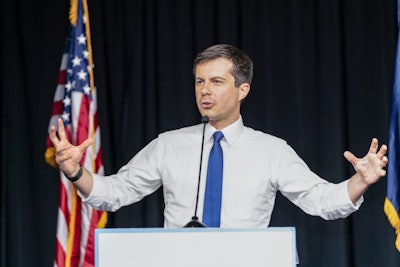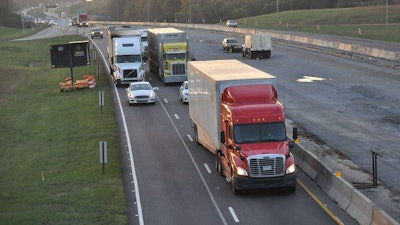Now that 2020 has been laid to rest, what might be on tap for trucking in 2021?
For starters, a shift in power in Washington will likely alter the regulatory and legislative landscapes. Congress is due to pass a highway bill, with the FAST Act’s expiration last month. DOT and FMCSA will see new leaders. Major court cases involving laws that restrict owner-operators in California and potentially other states will take their next steps. Also, 2020's freight and rates rally will find fresh hurdles.
Here’s what to watch for in the year ahead:
 A proposed rule to mandate speed limiters, which was halted in 2017 after President Trump took office, could be revived under the Biden Administration.
A proposed rule to mandate speed limiters, which was halted in 2017 after President Trump took office, could be revived under the Biden Administration.
Speed limiters, insurance hike regs potentially back on the table.
A change in the guard at the White House will see a new, likely more regulation-friendly administration, extending to the U.S. DOT and the Federal Motor Carrier Safety Administration. Moves made early in the Trump Administration to block or slow new federal regulations across all government agencies, such as the two-for-one executive order and the regulatory freeze, caused DOT to pull the plug on pending regulations like a speed limiter mandate, sleep apnea screening and treatment guidelines for drivers, and a rule to raise the minimum amount of liability insurance required of motor carriers, including owner-operators.

With President-elect Biden poised to rescind those orders and with new top brass entering DOT and FMCSA, those regs could be revived.
“It wouldn’t be surprising to see FMCSA pull these issues off the shelf and take another look at them,” said Lane Kidd, director of the Trucking Alliance, which represents some of the country’s largest trucking fleets and is an advocate of such safety regs.
An early draft of the proposed speed limiter mandate called for truck speeds to be governed at 60, 65 or 68 mph. That rulemaking was tabled in early 2017.
Likewise, an exploratory FMCSA rule that sought to evaluate the current $750,000 liability minimum for motor carriers was tabled in 2017, too, as was a rule that would have established clearer, more rigid criteria for examiners to use in screening drivers for obstructive sleep apnea and appropriate treatment drivers must receive if they do have apnea.
Watch for those regulations and potentially new ones to emerge under a Democratic-controlled Congress and White House.
 A decision could be handed down any day by the 9th Circuit Court of Appeals in the California Trucking Association's request for an ongoing exemption from the state's restrictive A.B. 5 law.
A decision could be handed down any day by the 9th Circuit Court of Appeals in the California Trucking Association's request for an ongoing exemption from the state's restrictive A.B. 5 law.
Still pending from the U.S. 9th Circuit Court of Appeals is a ruling in the California Trucking Association’s case against California’s A.B. 5 law, which took effect January 2020. The law was largely interpreted as restricting motor carriers’ ability to contract loads to owner-operators and other contracted truck drivers. However, the U.S. District Court in Southern California issued an injunction that blocks the state from enforcing the law against trucking companies pending CTA’s suit against the law. That decision on the temporary injunction could be issued any day.
And that decision could have major ramifications on similar laws -- even at the national level, said Joe Rajkovacz, head of government affairs at the Western State Trucking Association. “The decision...will likely determine the extent to which Congress under Democratic control pushes forward with nationalizing A.B. 5. A bill was entered last year to do exactly that. I suppose Congress could still move forward with the bill if they wanted but the overwhelming passage of Prop. 22 here in California should serve as a warning to Democrats on Capitol Hill that controversy surrounding this type of legislation is highly toxic – even with voters who traditionally support Democrats.” Prop. 22 was a ballot initiative to essentially exempt so-called "app-based" rideshare and delivery drivers from the A.B. 5 law. It passed with nearly 60% of the vote in favor.
Expect a 9th Circuit decision in the early months of 2021. CTA’s lawyers have said they’re prepared to see the case through to the U.S. Supreme Court.
Renewed focus on emissions regulations.
Biden has made clear that climate policy will be a priority for his administration, which could mean a renewed focus on emissions regulations by the federal government. What that will mean in terms of brass-tacks policy remains to be seen, but Biden plans to install new positions in the White House focused on making climate policies a priority across all departments. “The federal government is very likely to focus through modal agencies on pushing a green agenda,” said Rajkovacz.
 Who will head FMCSA under Pete Buttigieg, Biden's nominee to run DOT? It could be well into 2021 before a nominee is named.
Who will head FMCSA under Pete Buttigieg, Biden's nominee to run DOT? It could be well into 2021 before a nominee is named.
No names have been floated yet as to who might run FMCSA under a nominated DOT Secretary Pete Buttiegieg, but it’s “safe to assume it will be someone pro-safety,” said Kidd, which he sees as in line with FMCSA’s stated mission of reducing truck and bus crashes and fatalities.
Rajkovacz said don’t expect an announcement about an FMCSA nominee until the summer. “Whoever is selected I expect to be more adversarial to the industry and push for an increase in minimum insurance requirements through a rulemaking, and a review, if not outright reversal, of some the recent hours of service rule changes.”
Also relative to hours, will the incoming administration lay to rest a rulemaking evaluating shorter pause breaks for drivers' 14-hour clocks? In an Overdrive Radio podcast edition following the November election, OOIDA head Todd Spencer expressed hope that the agency would follow through on its proposed pilot program to test 14-hour clock pauses shorter than the minimum two hours required within the changed split sleeper rules. The Biden transition team said just this week that the reg could be on the chopping block.
 Look for the ongoing freight and rates rally to continue in 2021. FTR predicts truckload rates to climb by as much as 10% this year.
Look for the ongoing freight and rates rally to continue in 2021. FTR predicts truckload rates to climb by as much as 10% this year.
“Freight patterns in 2020 were unlike any other year,” said Paris Cole, CEO of Truckstop.com. He expects freight demand in 2021 to return to a more predictable and seasonal pattern -- slowness in January and early February, growth into spring and early summer, and then the usual slowdown through year’s end.
“In terms of load volumes, what we’re looking at is -- is this sustainable? Are we going to continue to have really strong freight volumes in the spot market? If so, for how long?” he said.
Should COVID-19 vaccines become widespread enough by mid-year that consumers start venturing out of their homes, the pandemic-driven surge in consumer-driven e-commerce could slow. “We could see a flip from goods over to services, and that would cause freight volumes to decline,” Cole said, noting that people would be more likely to go to ball games and restaurants instead of staying home and ordering goods online.
However, industrial activity is rebounding. That could put upward pressure on freight demand, should construction and manufacturing return to full force.
Avery Vise, vice president of trucking at FTR, said the ISM manufacturing index just posted its best month since August 2018.
He and Cole agree that flatbed could be a prime benefactor of renewed industrials activity -- on top of the strength the segment has already seen in recent months.
“It’s hard to conceive of a scenario in which 2021 is not a good year” for freight and rates, said Vise. FTR predicts rates to climb 10% on aggregate, which includes growth in both contract and spot rates.
 In addition to fresh rounds of highway funding, a highway bill could present an opportunity for a Democratic-controlled Congress to mandate new trucking reforms or regulations.
In addition to fresh rounds of highway funding, a highway bill could present an opportunity for a Democratic-controlled Congress to mandate new trucking reforms or regulations.
The 2015 FAST Act officially expired in December, but lawmakers extended the bill’s funding and policies through December 2021. Lawmakers could resume work on a long-term bill this year, which could mean good news for highway funding and infrastructure issues like truck parking. However, it could also mean another chance for lawmakers to enact new regulations.
Last year, House lawmakers proposed a FAST Act successor, the Invest in America Act, that did call for expanding truck parking with some $250 million, as well as reigning in unpaid dwell times at shippers and receivers. However, it also called for returning to public view carriers’ CSA scores and, in that early version, for halting then-yet-effective hours of service reforms.
Also, said Kidd, a highway bill or other infrastructure package could see policies around vehicle miles tax (VMT) -- either in addition to or in lieu of the per-gallon diesel tax that feeds the Highway Trust Fund. Buttigieg on the campaign trail advocated for a VMT at the federal level, said Kidd. “I think it would be an easy type of tax revenue measure for the trucking industry to incorporate so long as they were given credits for the fuel tax. I don’t think the industry would support paying both.”
VMT would also be effective in bringing electric vehicles into the fold in terms of paying their share of highway tax revenues, he said.









